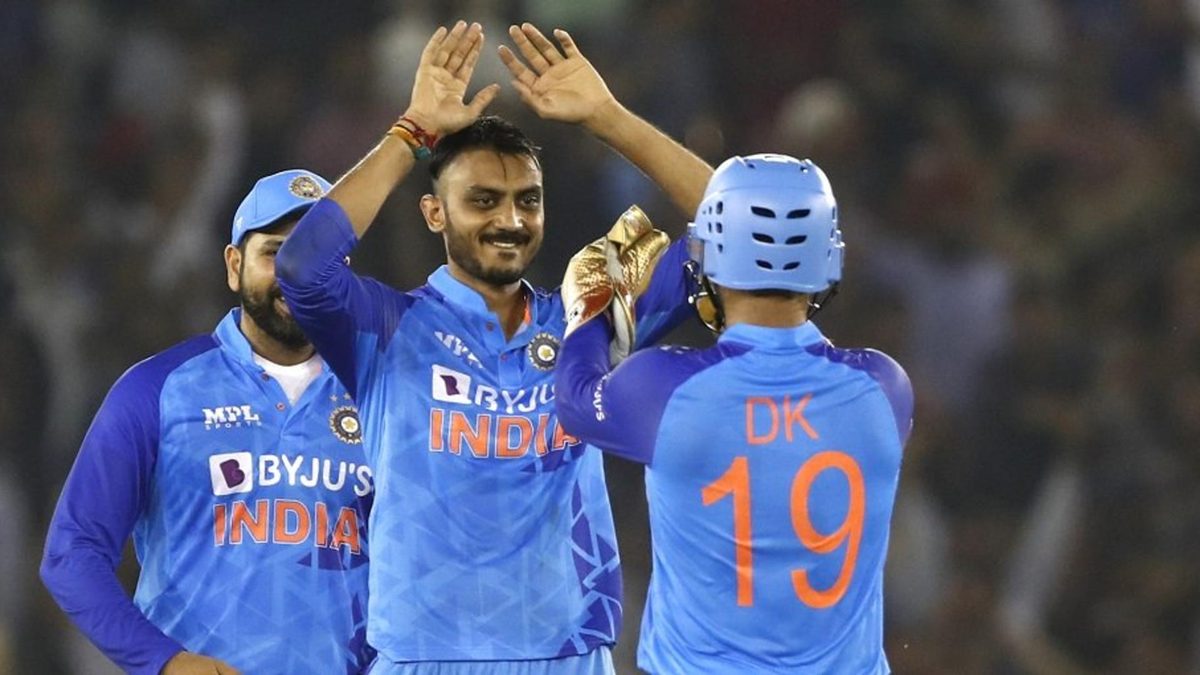
Axar Patel was not in the reckoning for a spot in India’s squad for the T20 World Cup. However, since Ravindra Jadeja’s injury paved the way for him, he has nosed past his illustrious rivals to emerge as India’s top-choice spinner for the tournament, writes Abhishek Mukherjee.
So impressive are his numbers in any format that it makes one wonder why Axar has not played for India more often. It is not often that you come across someone who, despite having 29 wickets at 22.68 apiece (while going at 7.17 an over) and 153 runs at a strike rate of 137, has played only 29 Twenty20 Internationals in over seven years.
In Test cricket, Axar’s case was made worse by the fact that India’s leading spinners – R Ashwin and Ravindra Jadeja – are also the best all-rounders. In the shorter formats, Jadeja rose through the batting order up in Hardik Pandya’s temporary absence, while Shardul Thakur, Deepak Chahar, Bhuvneshwar Kumar, Harshal Patel and their ilk covered up for the tail.
Axar was left with little choice but to bide his time. His best bet lay in India’s batters, none of whom bowls enough to be classified as a sixth bowler. At some point, India would have played a batter fewer; in that case, they would require more bowlers who would bat; and that was where Axar would fit in, more so because he was a left-hander – a rarity in contemporary Indian cricket.
Not for the first time in his career, an injury to Jadeja paved the way for Axar in the squad. He had been playing throughout this year, but that was more due to India’s numerous experiments with the squad. Against Australia, India decided to back their batting on a Mohali belter: they picked five batters (including the wicketkeeper) along with Hardik Pandya and five other bowlers.
It was a fail-safe strategy on a flat pitch, where the probability of a side getting bowled out is lower than them running out of bowlers to contain. India could have picked Ashwin as well – he evolved as a hitter up the order in the 2022 IPL – but being a left-hander worked in favour of Axar for two reasons.
First, India could now leave out Rishabh Pant, the only southpaw among their batters, a man who has somehow seldom got going in the shortest format in international cricket. And barring Matthew Wade, Australia did not have a left-hander in their line-up either.
Cometh the hour
India promoted Axar to five that night, with little effect. They failed to defend 209, but that was despite Axar, not because of him. The Australian onslaught forced India to bring Axar inside the powerplay: he responded with two runs and a wicket. He returned in the ninth over – his figures read 1.5-0-5-1 at one point – until Cam Green managed to clobber him for six.
Axar had his revenge next ball, on the other side of an over from Harshal, inducing a top edge off Green’s violent slog sweep. Australia needed 100 in 10 overs, but Axar held them back, conceding three off each of his last two overs, the highlight by a ball that bowled Josh Inglis round his legs.
He finished with 4-0-17-3. The next match, in Nagpur, was reduced to an eight-over slog-fest, allowing both sides to go in with a bowler less. India recalled Pant, but Axar had done enough to retain his place. They left out Bhuvneshwar.
Axar opened bowling, bowled Glenn Maxwell and Tim David, and conceded 13 off his two overs. In the decider, in Hyderabad, he had 4-0-33-3 – which included a ball that deceived the left-handed Wade.
With 4-0-22-1, Chahal clawed his way back in Hyderabad, but Axar’s series numbers (10-0-63-8) were superior to Chahal’s 8.2-0-76-2. In fact, with a 10-over cut-off, Axar has the third-best bowling average (7.87) and the second-best strike rate (7.5) by an Indian in T20Is. Ashwin, the man he kept out of the side, tops both lists (3.88 and 7.3 for his 11-1-35-9), but that came way back in 2016.
Leg-spinner Ravi Bishnoi heads the five Indian spinners who have bowled 10 overs this year, in both average and strike rate. Despite that, the selectors do not seem keen to leave Chahal, the senior leg-spinner, out of the XI. This season’s IPL Purple Cap might have influenced the decision; or perhaps the fact that the decision to leave out Chahal had backfired on India at the 2021 T20 World Cup.
Axar (18.93 and 14.5) is behind only Bishnoi (17.12 and 14.5) on both counts. He is ahead of Chahal (22.61 and 17.8). Axar’s economy rate is slightly inferior to Chahal’s, but the difference (0.2) amounts to under a run a match – a margin Axar’s batting can comfortably cover up for. Unless the opposition top-order is replete with left-handers, Ashwin – who has played five times this year – is unlikely to feature.
Of course, there are other factors as well. Over all these years, no touring left-arm spinner has taken more than six T20I wickets in Australia. Over the last three seasons, Steve O’Keefe is the only left-arm spinner to have taken 20 wickets at the BBL. Wrist-spinners typically thrive on those hard pitches.
Whether Axar’s bowling form, combined with the fact that he is a left-hander who can come up the order to slog, will be enough for the team management in Australia is something to be seen. The South Africa series may be interesting.








